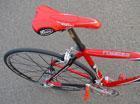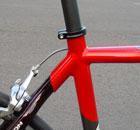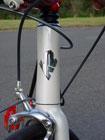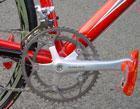Road test: K2 Mod 5.0Got tech? Send press releases, news, and tech questions to the Cyclingnews tech-heads. K who?By Anthony Tan Perhaps the most diverse outdoor sports company, K2 is known for its snowboards and skis and, for the last couple of years, for its well-regarded mountain bikes. The Mod 5.0 is the top model of a three-bike range of road machines, and it's a very impressive interpretation of modern road bike trends.
K2 has been making skis since 1961, and snowboards shortly after the snowboard boom started. The company moved into the bike scene when it acquired mountain bike manufacturer Pro-Flex in 1997. This year saw the first excursion off the dirt with a three-bike line-up of aluminium-framed road bikes: the Mod 3.0, Mod 4.0 and… wait for it… Mod 5.0. OK, the names are unimaginative, but the bikes are sweet. Top of the line and star of this test is the Mod 5.0, which sits above the Ultegra-equipped Mod 4.0 and 105-clad Mod 3.0 in the range. All three owe nothing to old-fashioned notions of bike frame design, instead boasting sloping, compact frames, concealed headsets, and plenty of carbon.
Although K2 is relatively new to the bicycle scene, their appeal has already caught the attention of Team DEVO, a professional US mountain bike outfit that includes on its roster Walker Ferguson, 2000 Junior Men's XC World Champion and 1999 Silver Medallist at the Cyclocross World Championships. On the roadMain test circuit for the Mod 5.0 was the challenging 2000 Olympic road race circuit in Sydney's picturesque Eastern suburbs. (For a refresher on the course profile or race, take a look here.) Roughly this time last year this course saw the finest one-day line up of professional cyclists ever assembled in Australia. Jan the Man displayed his awesome ability and destroyed all, capturing Olympic Gold for Germany, a triumph he places alongside his emphatic victory in the 1997 Tour de France. For those lucky enough to live in Sydney or who have ridden the circuit for fun, four laps of this 17km circuit provides enough of a physical test as well as a more than enough scope for analysis of the bike's road feel and handling. After all, those are the things we buy bikes for, right? Appearances have absolutely nothing to do with it. Yeah right. My main ride is a Pinarello Prince, and my first impression was that the Mod 5.0 offers a very similar ride. Both both frames are specced with an oversized aluminium downtube, carbon seat stays, raked carbon fork and an internal headset system. But enough tooling round the car park, let's get out on the Olympic circuit. Setting out along Driver Avenue, Moore Park, outside the gates of the Sydney Cricket Ground (both the start/finish of the road-race and time-trial course) I take a left turn and head along Anzac Parade. I move up a gear into a 39x14, spinning at around 95rpm, ŕ la Lance, before making a left turn into Darley Road. A gradual climb (800m at 5 per cent) begins. As I head towards the intersection of Carrington Road and McPherson St the levers shift effortlessly with the smooth action and precision that Dura-Ace is renowned for. Although it's relatively easy the first time through, I know this pinch will certainly test the legs by the third lap. I carefully negotiate the off-camber corner before sweeping down for 700m into Bronte beach. The K2 handles beautifully at speed, and confidently guides me around the corner — and a couple of pedestrians more concerned about the swell than the traffic. Par for the course in Sydney; the Olympic racers didn't have to put up with this. I immediately start the 1.2km climb of Bronte Hill, the hardest climb on the course at 6.6 per cent, split into three sections. With a quick flick of the left-hand lever, I settle into a steady rhythm, alternating between 39x16 and 17. Being multi-tiered, the climb is particularly deceptive. At first you believe you have conquered the climb, after a flat section of 150m, before abruptly facing an ascent of another 300m at 8 per cent towards the intersection at Carrington Road. Ullrich's wheetracks
A vehicle full of surfer dudes with a combined IQ of ten hurls abuse, using that all-too-familiar line "Get the F@#$! off the road you F@#$in wanker!". Given the fact I am still climbing and the lactic acid is slowly building up, I commend myself on my composure, and respond with just a middle-finger salute instead of a full-on attack of road rage. A short flat stretch of road to catch my breath before a fast, 300m sweeping descent that makes for some particularly scenic viewing. A series of three 90 degree turns follows, before a sharp right leads me back into Centennial Park from the Queens Park entrance at Musgrave Avenue. My confidence soars as I push the Vittoria Corsa CXs and the bike to their limit, pressing firmly on the outside pedal.
Darting straight through the middle of the Park along Parkes Drive before another tight right-hander into Grand Drive for 1.2km of up and down, I start believing I am in a crucial breakaway. Could it be? I stamp my authority on the pedals as I cruise past Driver Avenue once again to complete my second of four laps. The third lap is no problem; in fact it's one of those rare days where nothing seems to hurt. I am even complimented by a lovely mixture of bikini-clad blondes and brunettes, who yell out "nice bum mate!" while I'm track-standing at the traffic lights. Summoning the outer limits of my reserves of wit I concur with an "I know". This more than makes-up for those dickheads earlier on. By the fourth lap, the Lactic Brothers provide me with a warning: it's time to go home. So I call it a day, and ride out to an afternoon circuit race at Heffron Park to watch one of my friends race. As I arrive, envious eyes fall upon me. The questions, "Is this yours man?", "Can I touch it?" and "How much?" surface repeatedly. I decide I want one of these. I've never had so much attention since I was mistaken for Alvaro Mejia before the start of a kermesse in Belgium four years ago. Conclusion
Climbing on the K2 is a pleasure. The bike's geometry lends itself to the open road rather than the criterium circuit. The feather-like weight did initially make me feel slightly edgy on rough descents, though this was alleviated by increased familiarity with the bike.
As always, Dura-Ace functionality is unsurpassed, with excellent brake feel when descending at speed. Although it's now the standard, 39/53 chainrings with a 12-23 block is not really necessary in Sydney. An increasing number of road cyclists nowadays opt for a 42 inner chainring that allows you to stay in the small chainwheel for most training rides, while avoiding the "spinning out" effect. Mavic Ksyriums are arguably the ultimate road racing wheel. These were Lance Armstrong's personal choice for the last three Tours de France, despite the Posties being sponsored by Rolf. The slightly aero rims and bladed spokes offer the right amount of wind slicing without you being blown about in a crosswind. The predominant use of black adds a certain sexiness and mystique to an already sweet bike. The Selle Italia Flite saddle continues to be a popular choice in the professional peloton. A well-contoured shape, combined with the new addition of padded gel inserts provides a comfortable ride for those longer hauls without fear of numbness. With those unfounded rumours circulating that try to make a connection between excessive time spent on the bike and impotence, this saddle definitely alleviates any concerns, along with fear of saddle sores. Tech notesBy John Stevenson
Sizing: K2's Mod series bikes are available in just three sizes, S, M and L, in a manner similar to Giant's road bikes. At 180cm (5ft 11in) tester Anthony was borderline for the M test bike and might have been more comfortable on an L. K2 could make the process of fitting bike to rider a little easier by supplying a longer steerer and more spacers to give a wider adjustment range. Alternatively, there's the stylistic faux pas of a riser stem, but really… Steven Westover, himself a Cat 2 road racer, comments, "We are not going to lie and say it will fit everyone. I will say that we have been very successful in fitting everyone from as small as 5ft 3in to 6ft 4in quite easily without too many stem switches (we have color matched stems in many lengths in stock). Even if you have a stem that is as short as 9cm or as long as 13cm, the ride is not adversely affected. We believe that we can fit 90 per cent of the public with this compact, three size design. If you need anything larger or smaller you should be seeing a custom builder especially at that price point. If you are 6ft 6in you probably have some weird length arms or a short torso and that requires a special bike that no mass market manufacture can fit you correctly."
Also in the seating area, Selle Italia's Flite saddle benefits here from a thin layer of gel padding to take the edge off a seat that some love in its raw state and some find just a shade too minimal.
| |||||||||||
Full specification: K2 Mod 5.0Frame: K2 MOD double-butted & drawn aluminum w/RSI (Road Shock
Isolating) carbon fiber seatstays Claimed weight: 7.7kg (17lb) Cranks: Shimano Dura-Ace, 39/53T |
SRP: US$3,300Wheels: Mavic Ksyrium SSC Stem: 3T Forgio Pedals: Not included More information: K2's website | ||||||||||
GeometrySize Small Medium Large Head tube 115mm (4.5in) 138mm (5.4in) 162mm (6.4in) Top tube 532mm (20.9in) 550mm (21.7in) 580mm (22.8in) Chainstay 410mm (16.1in) 410mm (16.1in) 410mm (16.1in) Wheelbase 989mm (38.9in) 989mm (38.9in) 1003mm (39.5in) Head angle 72° 73° 73° Seat angle 74° 74° 73° Seat tube 470mm (18.5in) 520mm (20.5in) 570mm (22.4in) Fork offset 43mm (1.7in) 43mm (1.7in) 43mm (1.7in) BB height 280mm (11.0in) 280mm (11.0in) 280mm (11.0in) | |||||||||||









